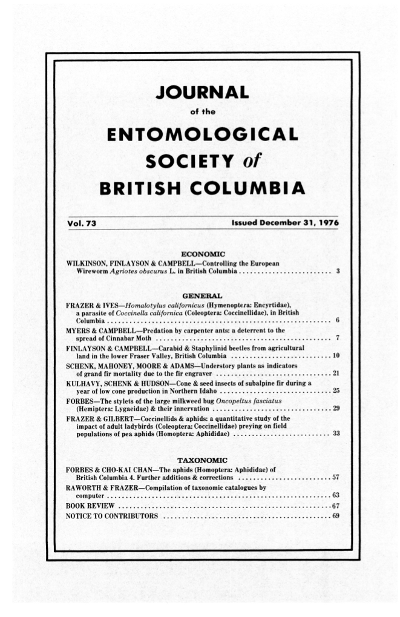Controlling the European wireworm, <i>Agriotes obscurus</i> L., in corn in British Columbia
Keywords:
European wireworm, <i>Agriotes obscurus</i>Abstract
Six insecticides at various rates and formulations, applied by three methods over three seasons, were evaluated for controlling the European wireworm. <i>Agriotes obscurus</i> L. in corn planted in silt loam. The insecticides were in granular form, applied as a broadcast, in a band, or in the seed furrow. Most of the materials, rates and methods gave good protection. Insecticide applied in the furrow was placed either in contact with the seed, or just ahead of it and mixed with soil. When it was in contact with the seed the yield was slightly lower, indicating some phytotoxicity. The furrow methods were the most economical in material and labour.References
Duncan, D.B. 1955. Multiple range and multiple F tests. Biometrics 11:1-42.
King, K.M., R. Glendenning, and A.T.S. Wilkinson. 1952. A wireworm (Agriotes obscurus L.) Can. Insect Pest Rev. 30:269-270.
Wilkinson, A.T.S. 1963. Wireworms of cultivated land in British Columbia. Proc. Entomol. Soc. Brit. Columbia. 60:3-17.
Wilkinson, A.T.S., D.G. Finlayson, and H.V. Morley. 1964. Toxic residues in soil 9 years after treatment with aldrin and heptachlor. Science 143:681-682.
Downloads
Published
Issue
Section
License
Authors who publish with the Journal of the Entomological Society of British Columbia agree to the following terms:
-Authors retain copyright and grant the journal right of first publication with the work simultaneously licensed under a Creative Commons Attribution License that allows others to share the work with an acknowledgement of the work's authorship and initial publication in this journal.
-Authors are able to enter into separate, additional contractual arrangements for the non-exclusive distribution of the journal's published version of the work (e.g., post it to an institutional repository or publish it in a book), with an acknowledgement of its initial publication in this journal.
-Authors are permitted and encouraged to post their work online (e.g., in institutional repositories or on their website) prior to and during the submission process, as it can lead to productive exchanges, as well as earlier and greater citation of published work (See The Effect of Open Access).


